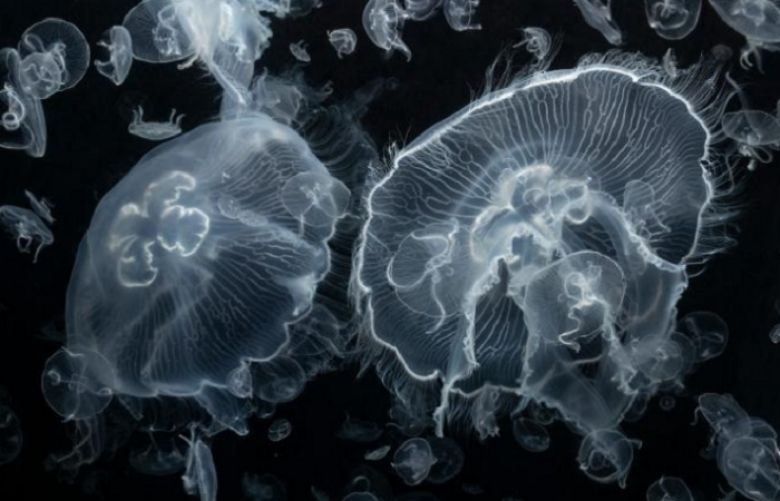GELATINOUS BLOBS WITH stinging tentacles may not sound like gourmet dining, but a new review of marine life shows that many species routinely snack on ocean jellies. In fact, some may depend on the calories they contain.
Jellyfish were previously thought to be a dead end for the food web due to their low nutritional content. On top of this, research has been sounding the alarm on the explosive growth of jelly populations due to climate change, overfishing, nutrient runoff, and habitat modification.
“I think a very negative perception of jellyfish came out, like ‘Watch out: they’re going to come and eat [you],’” says Jonathan Houghton, a biologist at Queen’s University in Northern Ireland.
But a review recently published in Trends in Ecology and Evolution which Houghton co-authored pulls together research showing that jellies play a more important role than thought in the oceanic food chain. And their importance may be on the rise as other food staples like some fish and krill decline in some areas.
A taste for jelly
To gather their data, Houghton and his co-authors analyzed the footage from creature cams attached to penguins and turtles, genetic studies on stomach contents, and stable isotope analysis of animal tissues. Taken together, this evidence shows that what jellies may lack in nutritional content, they make up for in availability and ease of capture. In a way, they are like the snack food of the ocean.
Houghton always knew that some animals relied on jellies for sustenance. The leatherback turtles he studies, for example, feed almost exclusively on blobs large and small. And these turtles likely time their oceanic migrations to coincide with expansive jellyfish blooms.
But an increasing amount of research now shows that a vast number of other creatures, including penguins, albatross, and tuna may turn to jellies for sustenance.
“It’s way, way more widespread in the food web than anyone ever would have thought,” Houghton says, “from crabs, to benthic microbes, to ducks.”
Jellyfish buffet
Jellies vary widely in their size and composition. Some, like the Portuguese man-of-war, aren’t even a single individual, but rather a composite of different organisms living in symbiosis. Other jellyfish species are minuscule, providing a bite-sized snack for smaller fish and sea creatures.
While some jellies prey on the larvae and eggs of fish, Houghton says the reverse is also true. Adolescent fish sometimes hang out underneath large species like compass jellies, which provide them with a degree of protection as well as a nutritious meal of nearly pure protein from eating the jellies’ “chunky gonads,” which exist in sometimes large numbers in these jellies, and can be plucked out by the sneaky fish.
“It’s like the gingerbread house hypothesis... like a house you can eat,” Houghton says, adding that sometimes whole colonies of fish will hang out around these jellies.
“There’s an awful lot in a jellyfish to eat beyond the straightforward, clear, transparent bell that everyone thinks of,” Houghton says.
Richard Brodeur, a fisheries biologist with the National Oceanic and Atmospheric Administration, agrees that jellies are much more important in marine food webs than they’re usually given credit for. He believes part of the reason is that jellies digest rather quickly and don’t have body parts that are easily identified in stomach contents.
Brodeur is currently working on a study examining a database of Pacific fish from the Bering Sea down the coast of California. His team found that even important fisheries species eat jellies, such as chum salmon, sablefish, and some rockfish. Plus, during times of the year when other prey species aren’t around, Brodeur says creatures like herring, anchovies, seabirds, and even some mammals may have to shift their palates towards jellies to subsist.
Changing oceans, changing diets
“There’s a good chance that having more food is going to be a good thing for turtles and other things that eat gelatinous plankton,” Brodeur says. But adding jellies to one’s diet is not without its risks. For example, leatherbacks have been found munching on plastic bags they mistook for jellies. More than half of sea turtles are estimated to have consumed plastic, and just 14 pieces of plastic can result in a turtle’s death according to one study, which may limit the recovery of these already vulnerable animals.
According to Houghton, some species of penguins are also adapting to jellies as an alternative source of food. The birds traditionally rely on krill, which live on the underside of ice sheets. But this habitat has been shrinking along with the sea ice as parts of Antarctica warm. While jellies have provided a sort of ecological buffer for penguins in the absence of enough krill, Houghton adds that a pure jelly diet isn’t necessarily going to work for all species.
“You need a specific metabolism, something like a slow leatherback,” he says. For other species, jellies are more like potato chips of the ocean, and they will definitely be impacted if their traditional food supply gets entirely replaced by jellies.
The most important takeaway, for Houghton, is emphasizing the need to expand our scientific understanding of these species. That way we can see their value as well as their limitations, rather than just viewing the jellyfish as the “gelatinous horsemen of the apocalypse.”







